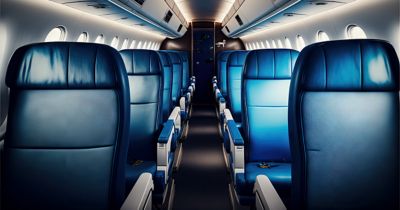-
United States -
United Kingdom -
India -
France -
Deutschland -
Italia -
日本 -
대한민국 -
中国 -
台灣
-
Ansysは、シミュレーションエンジニアリングソフトウェアを学生に無償で提供することで、未来を拓く学生たちの助けとなることを目指しています。
-
Ansysは、シミュレーションエンジニアリングソフトウェアを学生に無償で提供することで、未来を拓く学生たちの助けとなることを目指しています。
-
Ansysは、シミュレーションエンジニアリングソフトウェアを学生に無償で提供することで、未来を拓く学生たちの助けとなることを目指しています。
ANSYS BLOG
March 13, 2023
How Simulation Software Helps You Design Better Aircraft Cabin Lighting
With long flights, pressurized cabins, delays, packed overhead bins, middle seat assignments, and no leg room ... what could the interior cabin lighting of a plane possibly do to make things better?
There are many ways that aircraft cabin lighting can impact your overall flying experience.
- Comfort: The right lighting design can make you feel more comfortable during your flight. Lighting that is too bright or too dim can be uncomfortable for passengers, causing eye strain or difficulty seeing.
- Mood: The color temperature and intensity of the lighting can impact your mood. Warm, dim lighting can make you feel relaxed and sleepy, while cool, bright lighting can make you feel more alert and awake.
- Safety: Adequate lighting is essential for passenger safety. In an emergency, the lighting can be dimmed to provide better visibility for passengers and crew. The lighting can also be used to guide passengers to emergency exits and other safety features of the aircraft.
- Jet lag: Lighting design can also help to reduce the effects of jet lag. Some lighting systems are designed to mimic natural daylight patterns, which can help to regulate your body clock and reduce the symptoms of jet lag.
- Entertainment: In-flight entertainment systems rely on proper lighting to provide a high-quality viewing experience. With the right lighting design, you can enjoy movies and other entertainment options without any glare or distortion.

Overall, aircraft cabin lighting plays an essential role in creating a comfortable and safe environment for passengers during a flight. By using the right lighting design, designers can create an environment that meets the needs of passengers while also adhering to regulatory requirements and energy efficiency standards. However, lighting design for aircraft passenger cabins comes with several challenges. In this blog, we will discuss these challenges and how Ansys Speos can help designers overcome them.
Creating Comfy Environments
The first challenge in cabin lighting design is to create a comfortable and welcoming environment. The lighting needs to be bright enough for passengers to read and move around the cabin safely, but not bright enough to cause discomfort or glare. Speos can help designers prevent any problems by simulating different lighting scenarios, considering the position and orientation of the lighting fixtures and the type of light source used. Designers can adjust the light intensity, color temperature, and color rendering index to create an optimal lighting environment for passengers.
Meeting Regulatory Requirements
The second challenge is to ensure that the lighting design meets any regulatory requirements, as there are strict regulations regarding the amount and type of lighting allowed in passenger cabins. Speos can help designers ensure that their lighting design meets these requirements by providing accurate simulations that consider regulations and guidelines. This can save time and costs associated with physical prototyping and testing.
Energy Efficiency
The third challenge is to design lighting that is energy efficient and does not add extra weight to the aircraft. The weight and energy consumption of lighting fixtures can quickly add up and impact the aircraft's fuel efficiency. Speos can help designers optimize the lighting design by simulating the energy consumption and weight of different lighting fixtures. Designers can then make informed decisions about the type and position of lighting fixtures while still meeting required lighting levels.
Easy Installation and Maintenance
The fourth challenge is to design lighting that is easy to install and maintain. Lighting fixtures in cabins need to be easily accessible for installation and maintenance. Speos can help designers simulate the installation process and provide insight into the accessibility of the fixtures.
Designing lighting for cabins comes with several challenges that can impact passenger comfort, safety, and overall flying experience. Speos can help designers overcome these challenges by providing accurate simulations and optimization tools that consider the regulatory requirements, energy efficiency, and ease of installation and maintenance. By using Speos, designers can create lighting designs that provide a comfortable and safe environment for passengers while also meeting the requirements for weight and energy efficiency.
View our on-demand webinar, "Aircraft Interior Lighting Validation" to learn more about how Speos can enable designers to virtually validate the interior lighting of an aircraft passenger cabin — from setting up optical properties, ray tracing, RGB development, glare analysis, and validation of standards up to realistic human-vision rendering.










